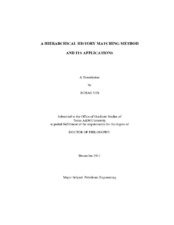| dc.contributor.advisor | Datta-Gupta, Akhil | |
| dc.creator | Yin, Jichao | |
| dc.date.accessioned | 2012-02-14T22:19:55Z | |
| dc.date.accessioned | 2012-02-16T16:18:32Z | |
| dc.date.available | 2012-02-14T22:19:55Z | |
| dc.date.available | 2012-02-16T16:18:32Z | |
| dc.date.created | 2011-12 | |
| dc.date.issued | 2012-02-14 | |
| dc.date.submitted | December 2011 | |
| dc.identifier.uri | https://hdl.handle.net/1969.1/ETD-TAMU-2011-12-10411 | |
| dc.description.abstract | Modern reservoir management typically involves simulations of geological models to predict future recovery estimates, providing the economic assessment of different field development strategies. Integrating reservoir data is a vital step in developing reliable reservoir performance models. Currently, most effective strategies for traditional manual history matching commonly follow a structured approach with a sequence of adjustments from global to regional parameters, followed by local changes in model properties. In contrast, many of the recent automatic history matching methods utilize parameter sensitivities or gradients to directly update the fine-scale reservoir properties, often ignoring geological inconsistency. Therefore, there is need for combining elements of all of these scales in a seamless manner.
We present a hierarchical streamline-assisted history matching, with a framework of global-local updates. A probabilistic approach, consisting of design of experiments, response surface methodology and the genetic algorithm, is used to understand the uncertainty in the large-scale static and dynamic parameters. This global update step is followed by a streamline-based model calibration for high resolution reservoir heterogeneity. This local update step assimilates dynamic production data.
We apply the genetic global calibration to unconventional shale gas reservoir specifically we include stimulated reservoir volume as a constraint term in the data integration to improve history matching and reduce prediction uncertainty. We introduce a novel approach for efficiently computing well drainage volumes for shale gas wells with multistage fractures and fracture clusters, and we will filter stochastic shale gas reservoir models by comparing the computed drainage volume with the measured SRV within specified confidence limits.
Finally, we demonstrate the value of integrating downhole temperature measurements as coarse-scale constraint during streamline-based history matching of dynamic production data. We first derive coarse-scale permeability trends in the reservoir from temperature data. The coarse information are then downscaled into fine scale permeability by sequential Gaussian simulation with block kriging, and updated by local-scale streamline-based history matching.
he power and utility of our approaches have been demonstrated using both synthetic and field examples. | en |
| dc.format.mimetype | application/pdf | |
| dc.language.iso | en_US | |
| dc.subject | History Matching | en |
| dc.subject | Uncertainty Quantification | en |
| dc.subject | Reservoir Simulation | en |
| dc.subject | Genetic Algorithm | en |
| dc.subject | Response Surface | en |
| dc.subject | Design of Experiments | en |
| dc.subject | Surrogate | en |
| dc.subject | Streamline Sensitivity | en |
| dc.subject | Shale Gas Reservoir | en |
| dc.subject | Fast Marching Method | en |
| dc.subject | Distributed Temperature Sensor | en |
| dc.title | A Hierarchical History Matching Method and its Applications | en |
| dc.type | Thesis | en |
| thesis.degree.department | Petroleum Engineering | en |
| thesis.degree.discipline | Petroleum Engineering | en |
| thesis.degree.grantor | Texas A&M University | en |
| thesis.degree.name | Doctor of Philosophy | en |
| thesis.degree.level | Doctoral | en |
| dc.contributor.committeeMember | Ehlig-Economides, Christine | |
| dc.contributor.committeeMember | Hill, Alfred D. | |
| dc.contributor.committeeMember | Efendiev, Yalchin | |
| dc.type.genre | thesis | en |
| dc.type.material | text | en |


